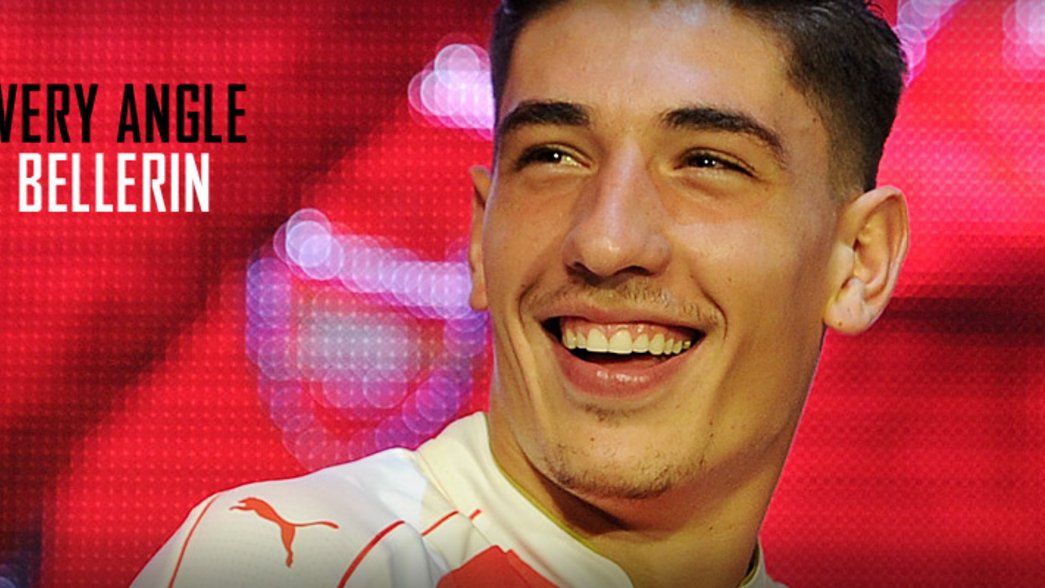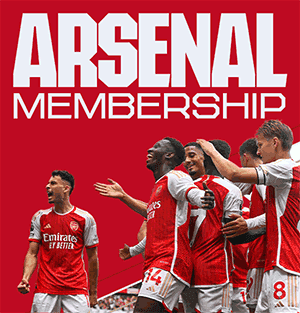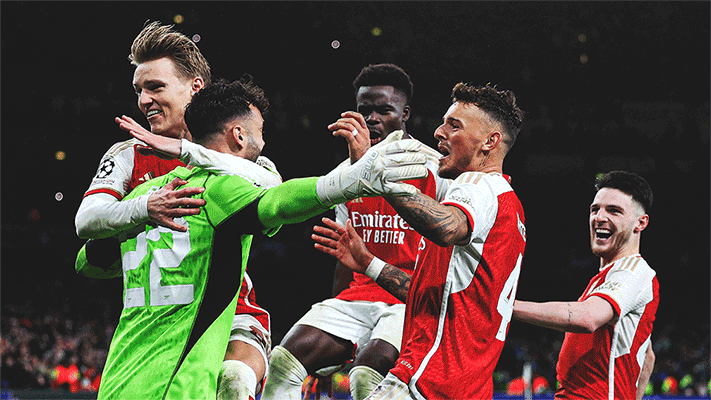Every month the Arsenal Magazine brings you the complete Gunners guide to members of our first team squad. This time, we profiled dynamic defender Hector Bellerin.
SUBSCRIBE TO THE ARSENAL MAGAZINE

This feature first appeared in November's Arsenal Magazine
Profile
Name: Hector Bellerin
Position: Defender
Squad number: 24
Nationality: Spanish
Born: Barcelona, Spain, March 19, 1995
Joined Arsenal: As a scholar in summer 2011
Previous clubs: Watford (loan) Arsenal debut: v West Bromwich Albion (a), League Cup, September 25, 2013 (drew 1-1, won on pens)
First Arsenal goal: v Aston Villa (h), League, February 1, 2015 (won 5-0)
Arsenal honours: FA Cup winner 2015, Community Shield winner 2015
Spain caps: U21 – 2 caps
Twitter: @HectorBellerin
He appeared more times in the position than any other player in Arsenal history, so LEE DIXON knows a thing or two about playing at right back.
His Gunners career spanned 14 years, during which time he won four league titles, three FA Cups, the League Cup and the European Cup Winners’ Cup – featuring under managers George Graham, Bruce Rioch and Arsène Wenger.
He racked up 619 outings in all competitions, placing him fourth in Arsenal’s all-time appearance list, before retiring at the end of the 2001/02 double-winning season.
Since then he has remained close to the game, and currently works as a TV pundit, covering the Premier League and international football.
So the 51-year-old is perfectly placed to evaluate Hector Bellerin’s nascent Gunners career to date. “Like everybody else I’ve been encouraged by his start,” he says. “He’s still a young boy learning his trade and I think that’s the key to it.

Lee Dixon
“We can all get a bit carried away with the enthusiasm o how well he’s doing. He had an unexpected start, I think, when he first got in the team.
“I spoke to Steve Bould when he first started to play and he told me he wasn’t really ready yet, but he was forced into the position because of injuries.
“To be fair to him, he took his chance and did brilliantly well. He overachieved as far as everyone’s expectations were concerned, and I’m sure he’s surprised himself a little bit as well. But he’s got a really bright future, I’m sure.”
Lee says he sees elements of himself in Hector’s game, though does have to concede that the Spaniard might have the edge in terms of speed. “Yes, he’s a bit quicker than I was! Though not that much – at my peak I was deceptively quick.
“But he’s lightning quick, and it’s well documented that he beat Theo Walcott in a few speed tests in training. That’s a big bonus for a full back, knowing you can chase anybody down.
“What it shouldn’t do, and hopefully won’t do, is give him a false sense of security, and he still needs to learn the position. I think sometimes slower full backs are better positionally, because they have to learn that side of the game.
“So as long as he learns the defensive side and positioning, I think he will go on to become a really top full back.”
Lee was part of the famous George Graham back four that conceded just 18 goals in the 1990/91 title-winning season, and was also a mainstay of Arsène Wenger’s defence that was breached only 17 times at the end of the decade during the 1998/99 Premier League campaign.
So the stats appear to support Lee’s assertion that the art of good defending is timeless. In fact he says he wouldn’t have to alter his style of play much to be a success in modern football.
“The game has certainly changed, there’s no doubt about that – it’s got quicker and the pitches are better,” he says. “But even if you take all that into consideration, it doesn’t matter what era you play in.
“If you learn where to be on the pitch at certain times, you can play in any team in any era. You might not be as flamboyant as modern full backs, and the game has changed with tackling too.
“It’s harder to win the ball now. Their ability to win tackles is restricted because there’s a yellow card if they mis-time it, and because of that defenders don’t often get tight enough.
“But I still think myself and Nigel Winterburn, if we were fit enough, would be able to play now, for sure. Our positional sense was probably our strength, and you never lose the need for that.
“A lot more is asked of full backs now in an attacking formation though,” Lee adds. "We used to get up and down the pitch too, but perhaps not as much as they do now.
“There’s less emphasis on covering now, but I still say to every young full back that I speak to that they should learn that side of it. Even if you think you might not need it, have it in the back of your mind.
"George virtually beat us with a stick every morning and had us doing back four work every single day of our lives"
Lee Dixon
“I always say full backs should try and play games without being noticed. If you get through a game and no one is talking about you, then in general as a full back you’ve probably had quite a good game.
"If you can come off the pitch with clean shorts it normally means you haven’t had to go to ground or make any slide tackles, which means you haven’t been out of position.
“But a lot of teams only play one up front now, so the full backs can be higher and don’t need to cover as much. Some of the positions the full backs take up now, they wouldn’t have been able to do that against two up front back in my day.
“They contribute huge amounts going forward now, but they kind of get away with it more at the back,” he sums up.
Lee believes his main attributes as a full back were his reading of the game and positioning, which he says can be drilled into defenders in training.
“I was a very attack-minded full back when I was at Bury and Stoke, in the early days of my career,” he recalls.
“When I came to Arsenal under George Graham it was a big culture shock because he said, ‘You’re not doing the things you are good at anymore – you have got to learn this now.’ And that basically meant how to be a defender.
“That put me in a really good position. George virtually beat us with a stick every morning and had us doing back four work every single day of our lives.
“So we learned where to be wherever the ball was on the pitch, and we learned where the other players should be to the point where the game almost became easy.
“The concentration was hard, but the physical side of it was easy because most of the time we were in the right position, and if we weren’t, our team mates knew and could cover.
“Defending is very much a team effort, the midfield as well. As a full back you also have your winger in front of you to look after.”
Arsenal’s defensive record has improved over the past few years, and Lee believes that with hard work, Hector can be part of a successful Gunners back four for years to come.
“With Hector, he’s such an attack-minded full back, very good on the ball, great passer, that if he learns the defensive side of being a full back – when to go, the positional side, when to tackle, when not to tackle, when to drop off – then he is going to be a top, top full back. But it takes years. It doesn’t happen overnight.
“It’s the more reserved full backs that I quite like, based on the way I used to play. That attacking side of the game comes naturally now because they’re taught that as kids, but I’d like to flip it back a bit and teach them a bit more about the negative side.
“I do some work with some kids’ teams and young pros. I always ask the full backs, ‘What’s your job?’ and they all say it’s to get wide, to get crosses in, but none of them say it’s to stop the ball going in the net.
“I try to pass on my experience and tell them the number one job as a defender is to keep the ball out of the net. If you do that,” he concludes, “you’ve got a very good chance of winning the game.”
Five moments which defined Hector’s Arsenal career
Signing for Arsenal
July 1, 2011
Aged 16, Hector joined the Arsenal academy as a first-year scholar after leaving Barcelona’s youth set-up, and immediately began the transformation from winger to full back.
The youngster’s attacking qualities are still very much evident in his play today, just as they were when he played his first official game for the club, on September 17, 2011.
The Under-18s, then coached by Steve Bould, hosted Bristol City and Hector was on the right flank, with Ben Glasgow (most recently to be found at Harlow Town) starting at right back.
Hector’s free kick led to the only goal of the game (for Alban Bunjaku) and the Spaniard’s career was up and running. Hector came to England at the same time as fellow Barcelona youth product Jon Toral, and speaking in December 2011, Hector said that helped his smooth transition to life at Arsenal.
“The fact that Jon had agreed to join Arsenal was a convincing factor. Leaving friends and family would be difficult, but I knew that we could support each other and that is the way it has been.
“To stay at Barcelona was an option,” he added. “But they do not give the opportunities to young players like those available at Arsenal.”
First-team debut
September 25, 2013
At the end of a successful debut season in England, in which he played 20 times for the youth and reserve sides, Hector signed his first-ever pro contract just after turning 17.
But it was his second season at Arsenal when he really caught the eye, and he was duly called up to sit on the bench for the first- team’s League Cup wins over Coventry City and Reading early in the campaign.
Hector had to wait another year to make his senior bow though – away to West Brom in the Capital One Cup third round. By now a Spain Under-19 international, Hector came off the bench early in extra time to replace Mikel Arteta and become the 818th player in Gunners history.
Playing in an unfamiliar central midfield role, he had a couple of pot- shots on goal, nearly scoring the winner late on, as Arsenal took their hosts to a penalty shootout, which they eventually won 4-3.
“I am proud,” Arsène Wenger said afterwards. “We played with many young players and they showed they are not only good footballers but that they can fight as well.
“I decided to go for young players with the penalties and they coped well with the pressure.”

Bellerin debut
Watford loan spell
November 2013-February 2014
Two months after his Arsenal debut, Hector was loaned to Championship side Watford to help quench his thirst for senior football.
The Hornets, managed by Gianfranco Zola at the time, were mid-table when Hector joined on November 22, originally on a short-term deal until the New Year.
His debut came in a 3-0 home defeat to Yeovil, and he remained in and out of the side, usually playing at right wing back. Zola was replaced by Giuseppe Sannino before Christmas, and he extended Hector’s loan deal until the end of the season, but Arsenal chose to recall him in mid-February.
He made eight league appearances in all. The highlight was probably his assist for Cristian Battocchio’s goal against Leeds, when he ran the length of the pitch before crossing with his left foot.
“I spent a good two months there,” Hector said recently. “I’m still in touch with Troy Deeney and a few of the other players. Some of the players are now at different teams but I made a lot of friends while I was there.
“I got a lot of experience and through those situations I learned a lot and made a lot of friends.”
Goal v Aston Villa
February 1, 2015
Hector’s first goal for the club was a moment that helped confirm he was fully at home in the Arsenal starting line-up.
After returning from Watford Hector didn’t break into the Arsenal first team until early in the following season, and his first start – against Borussia Dortmund in the Champions League – was something of a baptism of fire.
In fact Arsenal didn’t win any one of his first three starts, but the youngster soon showed his potential when stepping into an injury-hit back four in December. And when Mathieu Debuchy was ruled out in the New Year, Hector seized his opportunity.
He played 90 minutes as the Gunners beat Manchester City 2-0 away, then he grabbed a last-minute strike to seal the 5-0 home win over Villa.
Santi Cazorla rolled the ball to him 20 yards from goal and Hector placed his first time shot perfectly into the bottom corner.
“It was an amazing feeling,” he said afterwards. “It’s my first professional goal so I’m really happy. Thanks to all my team-mates, all the coaches and all the fans for the support they’ve given me. I’m really happy and really pleased for the team.”
Hector scored an even better goal against Liverpool later in the season, but this strike against Villa made people sit up and take notice of the teenage defender.
FA Cup final
May 30, 2015
The ideal way to crown a superb breakthrough season. It was only Hector’s 29th first-team appearance for the club, but he managed the experience at Wembley like a seasoned pro.
He won all three tackles he made (more than any other Arsenal defender), won 80 per cent of his duels (more than any other Arsenal defender) and made three interceptions (also more than any other Arsenal defender).
He also completed more passes than anyone else in the back four, more than playing his part in a dominant 4-0 win to earn the first silverware of his career.
“I can’t even believe it!” he said on the pitch after the game. “It’s been such an amazing season, and to have this to top it off has been amazing.
“This is a dream that everyone has as a kid to win a trophy like this in a stadium like this for a club like this, with all these players. I have no words, I’m just so happy.”
Arsène Wenger on Hector Bellerin
On his breakthrough season...
He was one of the surprises of the season last year. He went to Watford the year before, didn’t get many games so I called him back.
But what he’s doing at just 20 years of age is very good. He’s played against some great players already in his career. Maybe he still has some experience to gain, but his defending one against one is good, going forward he is good as well.
He has also proved he can score goals. He did that against Liverpool last season, a vital goal in a big game, and that always shows you that the guy has the mental quality to be there.
On his strengths...
Hector was always very good going forward when he was a kid. He was always questioned for his defensive responsibility and that’s where he has improved the most, without losing his drive going forward. I would say his defensive attitude and defensive reliability have vastly improved.
On his future...
His next challenge now is to confirm his talent this season. He is one of the players who emerged last year and had a very good season. He and Coquelin were not necessarily planned last season to come out and they have to confirm that this season. That’s always very difficult, to produce a similar performance in the second season.
That’s the challenge. He’s a very mature and very focused player. I’m confident he will have a good season again. He’s a very serious, mature boy.
I met him when he was 15, and I could see straight away that there was something special on the hunger side, on the desire and maturity side. He was a very mature boy very early.
The verdict
Francis Cagigao, the Arsenal scout who discovered Hector Bellerin
There were four or five good young players we were looking at in the same youth team at Barcelona, one of whom was Hector Bellerin. He was a right winger at the time, but what I’d said to Steve Rowley, the chief scout, is that I thought he’d make a great right back.
He had all the attributes of a successful full back – in fact he wasn’t dissimilar to Lauren, who was also playing as a right winger when I first saw him, at Mallorca.
But both he and Hector, although they were wingers, didn’t really have a lot of skill or tricks in tight situations. Hector wasn’t at his most comfortable when playing with his back to goal, or receiving the ball on the half turn.
Yet when he had space in front of him, things opened up for him because of his pace and his stamina. He could attack space well, and I also noticed he was diligent in tracking back, covering and putting players under pressure.
So Steve came over and watched a game with me when Hector played at right back against Espanyol. He did very well in that game – he really impressed us. At half time Steve came over to me and said, “Wow.” I said it was only the second time he’d played at right back, and he’d had a nightmare in his first game!
But it was obvious he was going to be a full back and Steve agreed he was a perfect fit. So I watched him in five more games, though he only played right back once more, against Brazil in a tournament. But I’d seen enough to know he was good enough to play right back.
So I found out a bit more about him, his character and so on, and we decided to bring him in. From the very first moment I met him and his family, they made it very clear that they were willing to join. In fact I remember saying to him, “You’re going to go on and play for Arsenal’s first team... as a right back!” they were surprised because they all saw him as a right winger.
Then I had a meeting with Hector and Arsène Wenger at Emirates Stadium. The boss came away from that first meeting and immediately said how impressed he was with his character and his maturity, which is always a big thing for the boss.
Since then he has done so well. He’s a kid who is willing to learn. He really wants to improve and take things on board. From the first moment I met him I could tell he was very focused, very ambitious and really wanted to do something with his career. And that’s not always the case with young players.
You could see he was bright, intelligent – the fact he picked up English within two or three months shows that. His personality helped him settle into life at Arsenal, and his attitude, together with the fact that he wants to listen, is a big plus for him. He’s still only 20, so there’s more to come from him, for sure.
[POLL: 896]
Copyright 2024 The Arsenal Football Club Limited. Permission to use quotations from this article is granted subject to appropriate credit being given to www.arsenal.com as the source.










